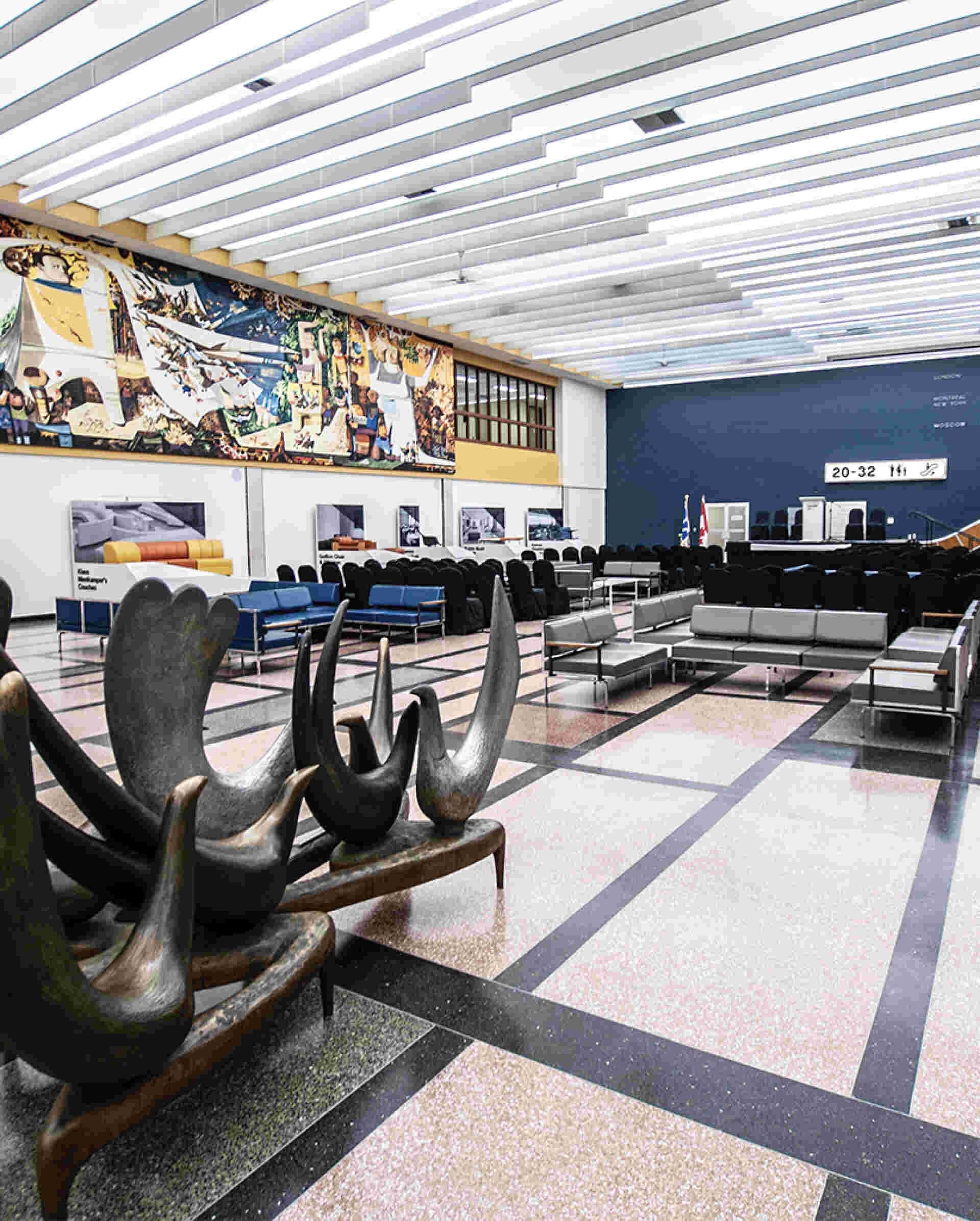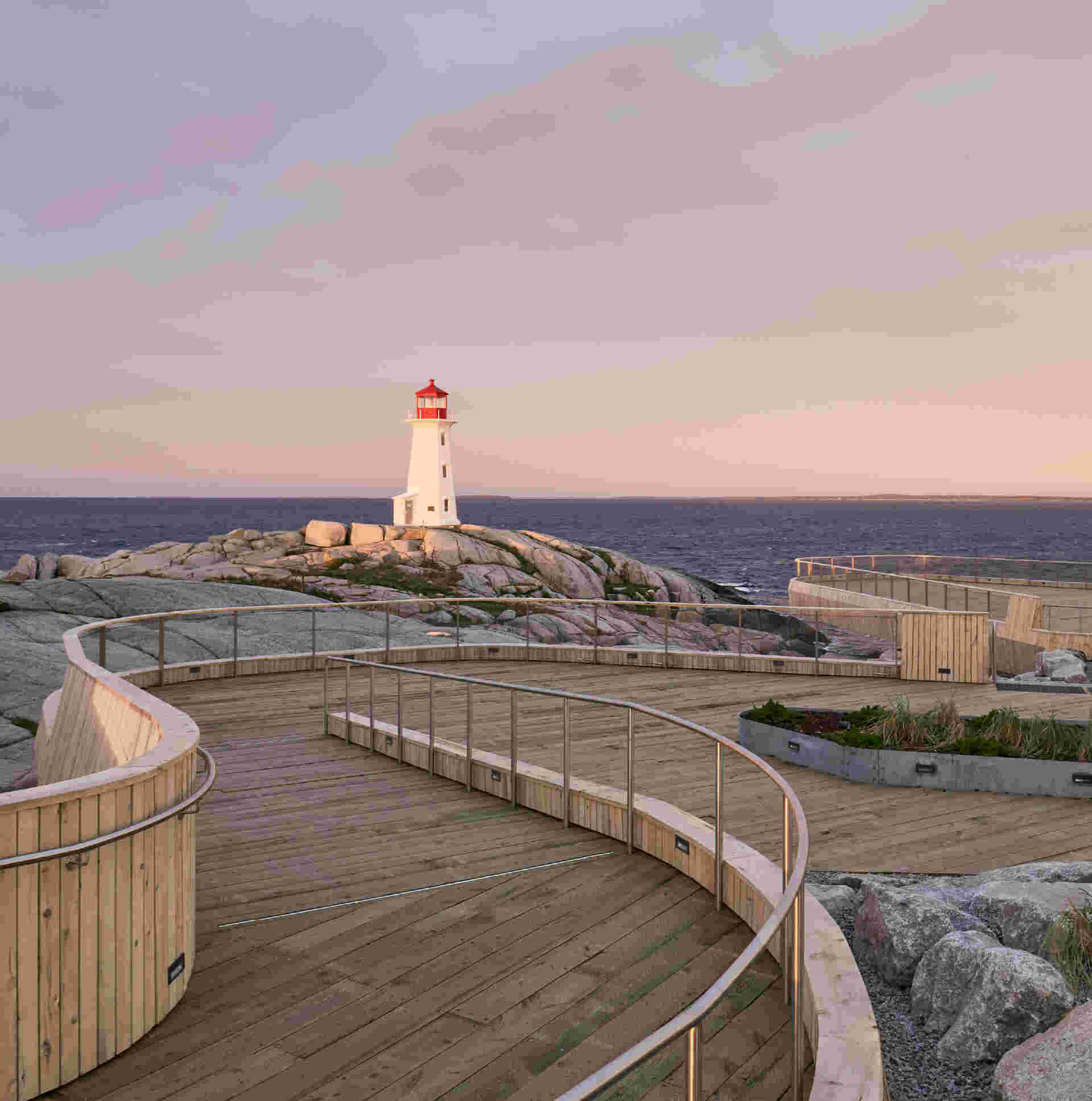
An Iconic Stopover
Work-In-Progress Gander Airport’s International Lounge—and its proud history—is now accessible to the non-travelling public.
By Brad McCannell and Kristen Habermehl
Photo by Maxime Brouillet

In 2021, an accessible viewing platform opened at Peggy’s Cove, making it possible for people who use a wheelchair or have other accessibility needs to enjoy the iconic lighthouse site in Nova Scotia. The site achieved a Gold rating from the RHFAC
Brad McCannell: The Rick Hansen Foundation’s mission statement to remove barriers for people with disabilities is broad on purpose so we can come at the problem from every possible direction. The trouble is, it has turned into a game of Whac-A-Mole. That’s where the RHFAC program comes in. It’s not another standard; it’s a rating system. We’re not the code police coming in and wagging our finger, telling you all the things you did wrong. We identify a site’s current level of accessibility so people know where to start.
Kristen Habermehl: One thing I really appreciate is how vastly different the Rick Hansen Foundation’s approach is from any other I’ve seen. I’ve never had a building manager come away saying they didn’t like the process. We have a positive approach and celebrate what’s been done well—even if we have to work hard to find one accessible thing in the building. Nine times out of 10, people just don’t understand what accessibility is supposed to look like. I’ve had people follow me around on ratings, rolling up mats as we go, saying they had no idea they were a tripping hazard.
BM: Being adversarial doesn’t help, so we wanted to bring industry to the table. Part of the problem is following regulations without understanding the impact. Almost 50 % of Canadian adults have or have had a permanent or temporary disability, or live with someone who does, yet we are still treated as a non-market. We often say if you build it, they will come.
KH: I was part of the Peggy’s Cove development from the initial design right through construction and to completion. In the summer, they achieved RHFAC Gold for what they accomplished. Seeing the number of people of every single ability using that space, interacting together and enjoying it equally, is the most rewarding thing you can imagine.
BM: Codes don’t address any kind of cultural issues or support building owners and tenants in making meaningful change. The code approach is “Thou shall do,” not “Thou shall understand.” Another issue is planners not understanding the population they’re building for. Architects need a lot more training too, but the bottom line is it’s not their decision. If management doesn’t prioritize accessibility, it won’t get in there.
“Once you start seeing barriers to people with disabilities, you can’t stop seeing them.”
KH: Before I knew about the RHF, I was working with my husband in our design/build company, and we completed a project for someone who needed full accessibility added to an existing home. We saw that we had significant gaps in our knowledge. By the end of my first RHFAC training session, my whole world had shifted. It was like all the kindling was in place and somebody lit the match. You don’t know what you don’t know.
BM: That’s an important point. Once you start seeing barriers to people with disabilities, you can’t stop seeing them.
KH: When you get to work with people who are the decision makers, they begin to realize what they don’t understand. It’s an amazing experience to work with people who haven’t understood what true, meaningful access looks like and then be part of helping them apply it.
BM: Meaningful access is really about that whole experience of using a facility from the moment you walk in the front door.
KH: To me it means somebody can independently and safely navigate the built environment with dignity. That means they don’t need somebody to help them up a steep ramp, for example.
BM: One of the biggest things to check is access to emergency exits. The building code works really hard at getting people with mobility disabilities into buildings, but it doesn’t give any thought to getting us out. There’s no requirement for emergency exits to be accessible. The next time you’re standing in front of an elevator, notice that little plaque that says “In case of fire, take stairs.” Where’s the little plaque that tells me what to do?
When you look at your facility, those kinds of things need to be identified really early so they can be addressed in the planning phase. If you have a building that meets all the building code’s minimum requirements, you’re still missing about 70 % of people with disabilities.
KH: And it doesn’t take much more money if you can do this in the planning stage.
BM: The problem when doing it the other way around is that the lifespan of buildings is 50 to 80 years. When you build in a problem, it becomes inaccessible by design. A good example of people recognizing this is the Royal Architectural Institute of Canada now incentivizing its members to take the RHFAC training course to help with that shift.
When someone wants their building to be accessible, my first question is “Accessible to whom?” People who are blind? People who are deaf? Is it going to be accessible to all people with all disabilities at all times? It doesn’t mean anything to say your building is accessible without saying—or knowing—to whom.
KH: One of the things that fascinates me every time I do a rating is how unaware employers are of the opportunity to hire from a greater pool of very capable employees if their buildings are accessible.
BM: The Conference Board of Canada says 57 % of people with physical disabilities who are willing and able to work are unemployed because of barriers in the workplace. This has so many other implications, too, because if we have jobs, we can have a bank account. If we have a bank account, we can get a credit card. If we have a credit card, we can get loans. If we have mortgages, maybe they’ll start building houses for us instead of against us.
KH: The truth is, if you’re not currently living with a disability, you’re a TAB—temporarily able-bodied. We are all just one step, one trip, one medical situation away from joining those who need further accessibility.
BM: And until we have access to the built environment, like the TABs, we can’t achieve full participation. If you can’t get in your car or get a taxi and go downtown to hit a pub, go to a friend’s house or join a protest, then you do not have full citizenship. COVID-19 showed us that really well. All of a sudden, the able-bodied population was like, “Oh my god, I can’t go to work, I can’t take a bus, I can’t go to a movie.” Welcome to our world.
KH: I think it’s up to every Canadian to start desiring meaningful access in all of our communities. People have to understand why it needs to happen, and that’s when we will really see momentum.
To learn more about how to improve your accessibility, visit WWW.RICKHANSEN.COM/RHFAC.